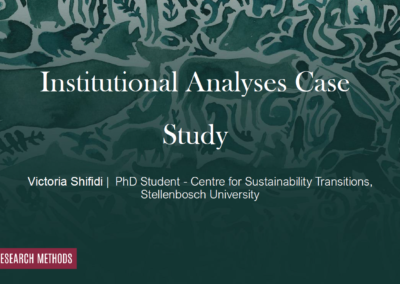This page focuses on institutional analysis, a leading interdisciplinary approach for analysing the structure of social-ecological systems (SES) problems and developing institutional solutions to address them. Institutional analysis is oriented around the role of institutions in shaping the incentives, opportunities and constraints that actors face as they interact with the environment and one another. The content on this page discusses lab experiments, field experiments, models/agent-based models, case studies and large-n analysis.
The Chapter summary video gives a brief introduction and summary of this group of methods, what SES problems/questions they are useful for, and key resources needed to conduct the methods. The methods video/s introduce specific methods, including their origin and broad purpose, what SES problems/questions the specific method is useful for, examples of the method in use and key resources needed. The Case Studies demonstrate the method in action in more detail, including an introduction to the context and issue, how the method was used, the outcomes of the process and the challenges of implementing the method. The labs/activities give an example of a teaching activity relating to this group of methods, including the objectives of the activity, resources needed, steps to follow and outcomes/evaluation options.
More details can be found in Chapter 22 of the Routledge Handbook of Research Methods for Social-Ecological Systems.
Chapter summary:
Epstein, G., Villamayor Tomas, S. & Schoon, M. (2022)
Method Summaries
Case Studies
Lab teaching/ activity
Tips and Tricks
- Crawford, S.E., and E. Ostrom. 1995. ‘A Grammar of Institutions.’ American Political Science Review 89(3): 582–600.
- McGinnis, M.D. 2011. ‘An Introduction to IAD and the Language of the Ostrom Workshop: A Simple Guide to a Complex Framework.’ Policy Studies Journal 39(1): 169–183.
- Ostrom, E. 2005. Understanding Institutional Diversity. Princeton: Princeton University Press.
- Ostrom, E. 2007. ‘A Diagnostic Approach for Going Beyond Panaceas.’ Proceedings of the National Academy of Sciences 104(39): 15181–15187.
- Thiel, A., M.E. Adamseged, and C. Baake. 2015. ‘Evaluating an Instrument for Institutional Crafting: How Ostrom’s Social-Ecological Systems Framework is Applied.’ Environmental Science and Policy 53: 152–164.

